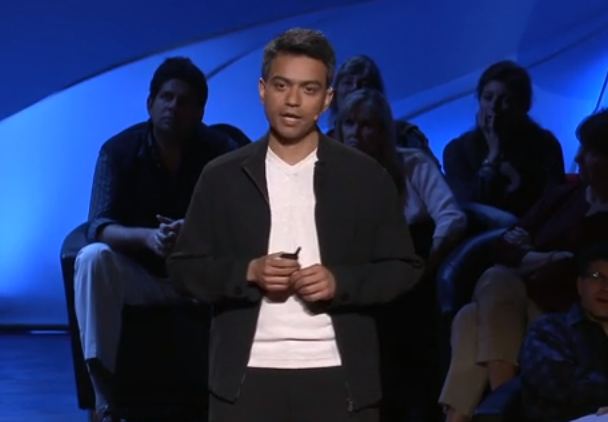And just for contrast, we can do this with any word.
相對,你也可以為其他詞匯勾勒詞景
We can take the word "bye" as in "good bye."
比如“goog bye”(再見)里的“bye”字
And we're now zoomed in over the entrance to the house.
我們放大到房子大門口附近
And we look, and we find, as you would expect,
我們看到,我們發現,你也會想到
a contrast in the landscape where the word "bye" occurs much more in a structured way.
一幅相對的景象,在那兒你看到“bye“高頻率出現的結構
So we're using these structures to start predicting the order of language acquisition, and that's ongoing work now.
我們用這些結構,開始預言學會語言的順序,這是在持續進行的工作

In my lab, which we're peering into now, at MIT -- this is at the media lab.
在我麻省理工學院的研究室--就是現在看到的,那是在媒體實驗室里
This has become my favorite way of videographing just about any space.
這成了我最喜歡的空間視頻制圖方法
Three of the key people in this project, Philip DeCamp, Rony Kubat and Brandon Roy are pictured here.
這個項目的關鍵人物都在,就是圖片里的菲利普·迪坎普,羅尼·庫巴特和布蘭登·羅伊。
Philip has been a close collaborator on all the visualizations you're seeing.
菲利普是一個密切的合作者,你們看到的視覺化功能就是他負責的
And Michael Fleischman was another Ph.D. student in my lab who worked with me on this home video analysis,
還有麥克爾·菲萊舍曼是我實驗室的另一個博士生,和我一起做了家庭視頻的分析
and he made the following observation:
是他發表了以下的觀點:
that "just the way that we're analyzing how language connects to events which provide common ground for language,
“我們分析語言如何與事件相關,這是語言的共同的基礎
that same idea we can take out of your home, Deb, and we can apply it to the world of public media."
我們可以把同樣的思路帶出你的家,戴,我們可以把它用到公共媒體上”
And so our effort took an unexpected turn.
所以我們的研究有了個意想不到的轉折
Think of mass media as providing common ground and you have the recipe for taking this idea to a whole new place.
想到大眾媒體提供共同的基礎,你就可以把我們的方法運用到一個嶄新的地方。











